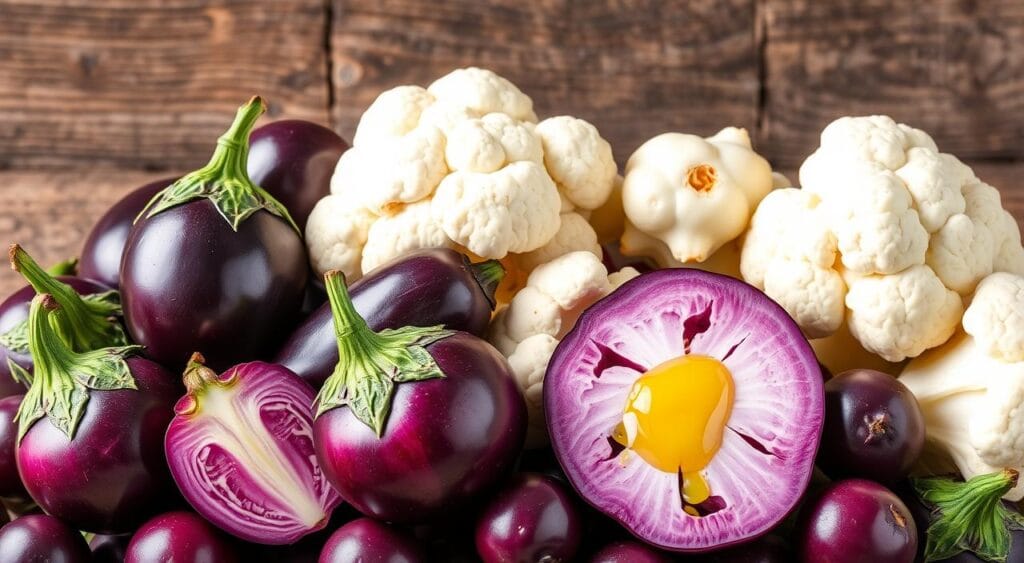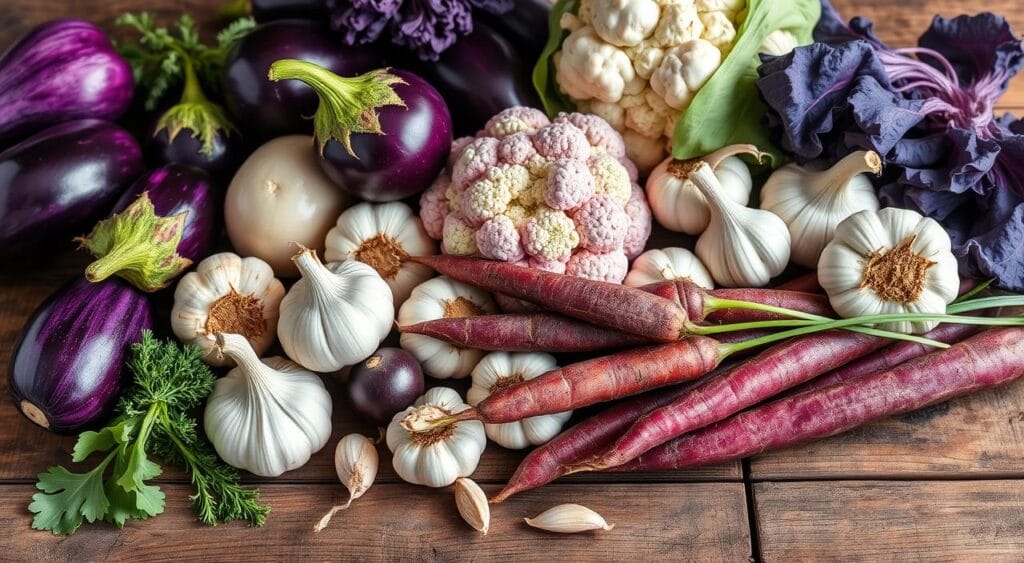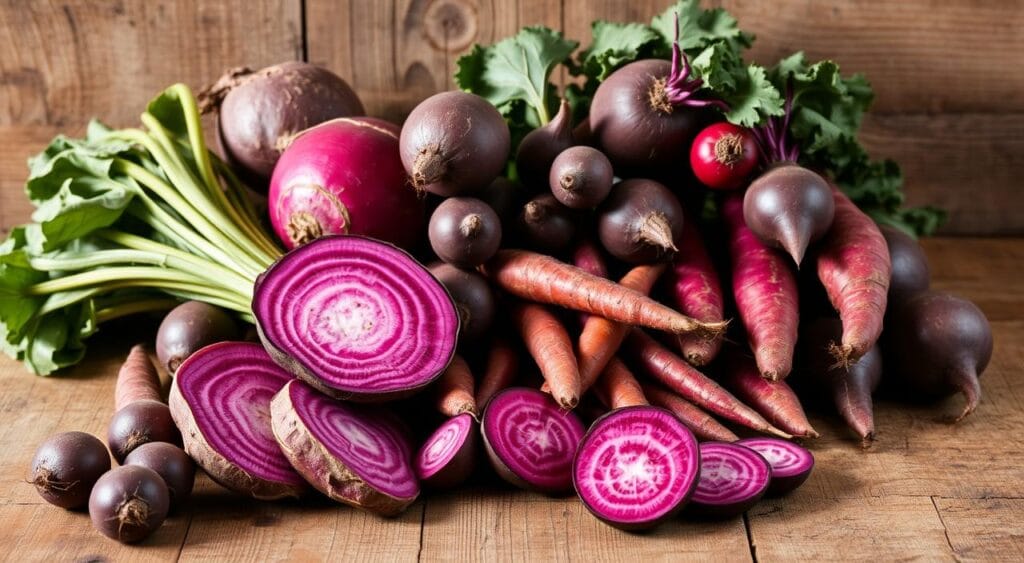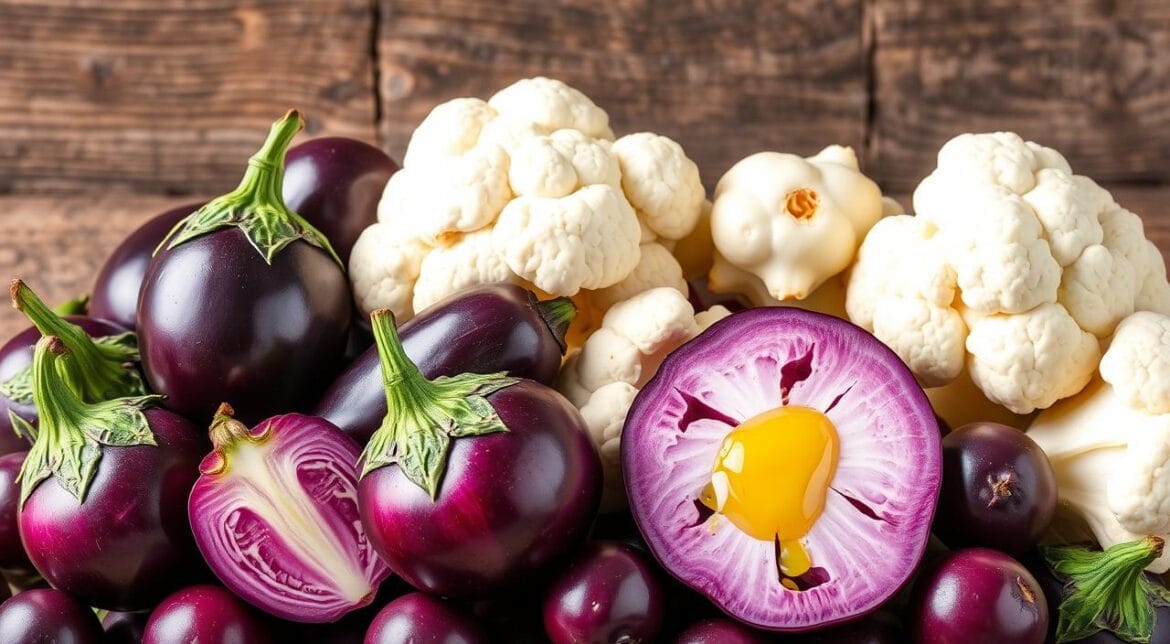Table of Contents
Explore the colorful world of purple and white vegetables. These vibrant foods are full of nutrients. They add beauty to your meals and offer health benefits.
This guide will show you the science behind their colors. You’ll learn about their health perks and how to use them in your cooking. It’s perfect for anyone looking to try new recipes.

Key Takeaways
- Discover the fascinating science behind the pigmentation of purple and white vegetables.
- Explore the remarkable health benefits of these colorful produce, from boosting immunity to promoting heart health.
- Learn how to incorporate more purple and white vegetables into your diet, including simple meal ideas and shopping tips.
- Understand the seasonal availability and proper storage methods for these unique vegetables.
- Discover the antioxidant properties of purple vegetables and their potential role in disease prevention.
Understanding Purple and White Vegetables: A Natural Color Spectrum
Vegetables come in many colors, and each color has its own health benefits. Purple and white vegetables are especially interesting. Their colors come from special compounds that can help our bodies.
The Science Behind Purple Pigmentation
Purple vegetables like potatoes and carrots get their color from anthocyanins. These pigments are found in many fruits and veggies. They are strong antioxidants that can help us stay healthy.
White Vegetables and Their Unique Properties
White veggies like cauliflower and parsnips don’t have green color because they lack chlorophyll. This lets their natural white or pale colors show. They have different compounds that are good for us.
Natural Compounds That Create These Colors
- Anthocyanins: These water-soluble pigments are responsible for the deep purple hues in vegetables like purple cabbage, purple potatoes, and purple carrots.
- Carotenoids: Found in white vegetables like cauliflower and parsnips, these fat-soluble compounds contribute to the vegetables’ pale or white coloration.
- Flavonoids: In addition to anthocyanins, other flavonoid compounds can also impart purple or white tones to vegetables, such as the flavonoid quercetin in onions.

Learning about the science behind vegetable colors helps us value their health benefits. Each color comes from special compounds that are good for us.
Health Benefits of Purple Root Vegetables
Purple root vegetables are not just pretty; they’re also super good for you. They’re full of nutrients and antioxidants. These help fight off harmful free radicals and lower disease risks.
These veggies get their purple color from anthocyanins, powerful antioxidants. Anthocyanins protect your cells from damage. They’re key to keeping you healthy.
Research shows purple veggies like carrots and potatoes have four times more antioxidants than regular ones. Adding them to your meals boosts your health and well-being.
Purple veggies might also help fight cancer. Their anthocyanins and other compounds can slow cancer cell growth. This makes them a strong ally in cancer prevention.
Plus, their deep color means they’re packed with vitamins, minerals, and fiber. These nutrients are great for your heart, brain, and digestion. They keep you feeling your best.

Adding purple root vegetables to your diet is a smart move. They’re not just good-looking; they’re also full of health benefits. They’re a tasty and nutritious choice for anyone looking to improve their health.
White Vegetables: Hidden Nutritional Powerhouses
White vegetables are often overlooked, but they are full of nutrients. They help boost your immune system, support digestion, and keep your heart healthy. These purple and white vegetables are worth exploring.
Immune-Boosting Properties
White veggies like cauliflower, onions, and garlic are packed with vitamin C. This vitamin is a powerful antioxidant that enhances your immune system. Eating these purple and white vegetables regularly can help fight off sickness.
Digestive Health Benefits
White veggies, including mushrooms and artichokes, are high in dietary fiber. Fiber is essential for maintaining a healthy gut and promoting regular bowel movements. Adding more purple and white vegetables to your diet can improve your digestion.
Heart-Healthy Attributes
Onions and leeks have compounds that can lower cholesterol and blood pressure. These are good for your heart. Eating these purple and white vegetables can help keep your heart healthy.
| White Vegetable | Key Nutrients | Health Benefits |
|---|---|---|
| Cauliflower | Vitamin C, Fiber, Folate | Immune Support, Digestive Health, Cardiovascular Protection |
| Onions | Vitamin C, Fiber, Quercetin | Immune Boosting, Heart Health, Digestive Support |
| Mushrooms | Vitamin D, Fiber, Selenium | Immune Function, Gut Health, Antioxidant Protection |
Adding purple and white vegetables to your meals can boost your health. They support your immune system, heart, and digestion. These veggies are true health heroes.
Popular Purple Leaf Vegetables in Your Garden
Gardening fans looking to brighten their gardens should check out purple leaf vegetables. These plants make your garden look great and add nutrients to your meals. Purple kale and red cabbage are just a few examples of the colorful purple fruits and vegetables you can grow.
Purple basil is a favorite among gardeners. It loves sunny spots and well-drained soil. It’s perfect for adding flavor to pesto, salads, and even drinks. Red romaine lettuce is another great choice. It’s not just pretty; it’s also full of vitamins and antioxidants.
- Purple kale
- Red cabbage
- Purple basil
- Red romaine lettuce
Think about using these purple leaf vegetables as borders, in pots, or as the main attraction in a raised bed. Their bright colors and strong growth make them a standout in any garden.
“Bright purple fruits and vegetables are not only visually striking, but they also provide numerous health benefits.”
Why not add purple leaf vegetables to your garden this year? With a bit of creativity and care, they can turn your garden into a feast for the eyes and taste buds.
Essential White Vegetables for Your Kitchen
White vegetables are just as important as their purple counterparts. They add nutrition and flavor to any dish. From cauliflower to potatoes, they’re a must-have in your kitchen.
Storage Tips for White Vegetables
Keeping white vegetables fresh is crucial. Here’s how to do it:
- Store them in the fridge, away from sunlight and heat.
- Use a damp paper towel or a perforated bag to keep them moist.
- Don’t wash them until you’re ready to use them to prevent spoilage.
- Consume them within a few days for optimal taste and texture.
Preparation Methods
White vegetables can be prepared in many ways. Here are some favorites:
- Roasting: Toss them with oil, salt, and pepper, then roast until tender.
- Steaming: Steam them gently to keep their nutrients and crispiness.
- Sautéing: Sauté them quickly in oil or butter for a tasty side.
- Mashing: Boil and mash them for a creamy dish.
Seasonal Availability Guide
| White Vegetable | Peak Season |
|---|---|
| Cauliflower | Fall and Winter |
| Onions | Summer and Fall |
| Potatoes | All Year Round |
| Parsnips | Fall and Winter |
| Mushrooms | All Year Round |
Adding white vegetables to your kitchen opens up new culinary adventures. They’re not only delicious but also packed with health benefits.
Cooking with Purple and White Vegetables
Explore the vibrant world of purple and white vegetables in your cooking. These colorful foods not only look great but also pack a nutritional punch. Try roasting purple root vegetables or sautéing purple fruits and vegetables to bring out their flavors.
To keep their colors bright, avoid overcooking. Instead, use gentle methods like steaming, roasting, or sautéing. This helps keep their natural pigments and nutrients intact.
Be creative with how you mix flavors with these vegetables. For example, pair roasted purple root vegetables with a tangy balsamic glaze. Or add purple fruits and vegetables to salads with nuts, citrus, and herbs.
“Incorporating purple and white vegetables into your cooking is a wonderful way to enhance both the visual appeal and nutritional value of your meals.”
Unlock their full potential by thinking about how you prepare and present them. Try different cooking methods and flavor combinations. This will highlight their beauty and nutritional value.
Preserving Color and Nutrients
- Avoid overcooking to prevent color loss
- Choose gentle cooking methods like steaming, roasting, or sautéing
- Use acidic ingredients like lemon juice or vinegar to help maintain vibrant hues
Pairing Suggestions
- Roasted purple root vegetables with a balsamic glaze
- Purple fruits and vegetables in vibrant salads with nuts, citrus, and herbs
- Sautéed purple and white vegetables with garlic, olive oil, and a sprinkle of parmesan
Make the most of purple root vegetables and purple fruits and vegetables in your cooking. With a bit of creativity, you can create dishes that are both beautiful and healthy. These dishes will not only please your taste buds but also support your health.
Antioxidant Properties of Purple Vegetables
Purple vegetables are not just beautiful, but they also have amazing health benefits. Their vibrant colors come from anthocyanins, powerful antioxidants. These compounds fight off free radicals and protect your body from oxidative stress.
Free Radical Fighting Power
Antioxidants in purple vegetables are great at stopping free radicals. These unstable molecules can harm cells and lead to chronic diseases. The antioxidants in purple vegetables help keep your body balanced, reducing inflammation and promoting health.
Anti-Aging Benefits
The antioxidants in purple vegetables also have anti-aging properties. They fight oxidative stress, which can make you look older. This may help keep your skin young, support your brain, and protect against age-related diseases.
Disease Prevention Potential
Many studies show that eating purple fruits and vegetables can lower disease risk. This includes some cancers, heart disease, and neurodegenerative conditions. The antioxidants and anti-inflammatory effects of these phytochemicals are key.
Adding more benefits of purple vegetables to your diet is easy and beneficial. Try different purple and white vegetables. They can help support your body’s natural defenses.
Seasonal Growing Guide for Purple and White Crops
Exploring the world of purple and white vegetables is exciting. They need specific growing conditions to thrive. This allows gardeners to grow a wide variety of colors for their plates.
Optimal Planting Times
Purple root vegetables like purple root vegetable do best in spring. They love cooler soil and plenty of water. On the other hand, purple leaf vegetable types prefer planting in mid-summer. This lets them grow well in the warmest months.
Soil and Care Requirements
- Both purple and white veggies need well-draining, rich soil.
- They also need regular water and consistent moisture.
- Make sure they get 6-8 hours of sunlight a day.
- Using row covers or cloches can help protect them from pests and extend the growing season.
Maximizing Yields
To get the most from your harvest, try succession planting. This means planting purple root vegetable and purple leaf vegetable crops at different times. It keeps your garden full of fresh veggies all season.
| Vegetable | Planting Time | Soil Needs | Sunlight Requirements |
|---|---|---|---|
| Purple Carrots | Spring | Well-draining, sandy loam | 6-8 hours per day |
| Purple Kale | Mid-Summer | Nutrient-rich, moist soil | 6-8 hours per day |
| White Onions | Early Spring | Well-draining, fertile soil | Full sun |
By learning about the special needs of purple and white veggies, gardeners can grow a colorful and healthy harvest all year. Enjoy the beauty of these crops and the delicious flavors they bring to your table.
Purple and White Vegetable Preservation Methods
Keeping purple and white vegetables fresh is a big challenge for everyone. From freezing to canning, there are many ways to keep these veggies tasty all year. These methods help you enjoy their unique flavors and nutrients.
Freezing Purple and White Vegetables
Freezing is a simple way to keep purple and white veggies fresh. First, clean and blanch them. Then, put them in airtight containers or bags. This keeps their colors bright and nutrients intact. Just thaw and use them in your recipes.
Canning for Long-Term Storage
Canning is great for keeping veggies fresh for a long time. The heat kills bacteria and seals in flavors. Make sure to can them right to keep them nutritious.
The Art of Pickling
Pickling turns purple and white veggies into tasty treats. The brine keeps them colorful and crunchy. Try different spices to make your pickles unique.
Dehydrating for Convenient Snacks
Dehydrating saves the veggies’ colors and flavors. It removes moisture but keeps nutrients. Enjoy dehydrated veggie chips or slices as healthy snacks.
| Preservation Method | Key Benefits | Preparation Tips |
|---|---|---|
| Freezing | Locks in color and nutrients | Blanch before freezing, use airtight containers |
| Canning | Extends shelf life, preserves flavors | Follow proper canning techniques |
| Pickling | Enhances colors, adds unique flavors | Experiment with different spices and herbs |
| Dehydrating | Concentrates flavors, creates convenient snacks | Retain natural vitamins and minerals |
Learning these preservation methods lets you enjoy purple and white veggies all year. They add beauty and health to your meals.
How to Incorporate More Purple and White Vegetables Into Your Diet
Adding more purple and white veggies to your meals is easy and fun. These colorful foods are packed with nutrients. They help keep your body healthy and strong.
Simple Meal Planning Ideas
Begin by adding purple and white veggies to your meal plan. Roast cauliflower, parsnips, or purple potatoes as a side. Add shredded purple cabbage to your salads.
You can also blend purple carrots or white onions into soups. This adds color and taste.
Kid-Friendly Purple and White Vegetable Recipes
- Purple Potato Wedges: Toss cubed purple potatoes with olive oil, garlic, and your favorite seasonings, then bake until crispy.
- Cauliflower “Mashed Potatoes”: Blend steamed cauliflower with a touch of butter, milk, and salt and pepper for a creamy, kid-approved side dish.
- Rainbow Veggie Skewers: Thread pieces of purple cabbage, white mushrooms, and other colorful vegetables onto skewers for a fun, interactive way to encourage kids to try new foods.
Shopping and Selection Tips
When buying purple and white veggies, choose vibrant colors and avoid blemishes. Look for locally grown and seasonal produce for the best taste. Try new veggies like purple carrots or white asparagus to explore different flavors.
By adding more purple and white veggies to your diet, you open up a world of health benefits and tasty dishes. Try new recipes, involve your family, and enjoy the vibrant colors and tastes these veggies bring.
Conclusion
The purple and white vegetables are full of health benefits. They have antioxidants and unique nutrients. These veggies should be a big part of your diet.
Adding these colorful veggies to your meals brings new flavors and textures. They also boost your health in many ways. They help your immune system, digestion, and add variety to your meals.
Keep exploring the world of purple and white vegetables for a healthier life. With creativity and a focus on wellness, you can enjoy their benefits for years. Discover new ways to add them to your daily routine.
FAQ
What are the benefits of purple vegetables?
Purple vegetables are full of antioxidants and compounds that help your health. They fight off free radicals and support anti-aging. They also help prevent some diseases. Plus, they’re rich in vitamins, minerals, and fiber, making them great for your diet.
How can I incorporate more purple and white vegetables into my diet?
Adding purple and white veggies to your meals is easy. Try planning your meals with them in mind. Look for kid-friendly recipes and choose them when you shop. Using seasonal and preservation techniques can help you enjoy them all year.
What are some popular purple leaf vegetables?
Purple kale, red cabbage, purple basil, and purple Brussels sprouts are favorites. These colorful veggies add unique flavors and interest to your dishes. You can even grow them at home.
What are the unique properties of white vegetables?
White veggies like cauliflower, onions, and garlic are packed with benefits. They boost immunity, support digestion, and are good for the heart. Even though they’re not as colorful, they’re nutritional powerhouses.
How do the natural pigments in purple and white vegetables affect their nutrition?
The colors in purple and white veggies come from natural pigments. Anthocyanins in purple veggies are strong antioxidants. White veggies, lacking chlorophyll, highlight other beneficial compounds.

